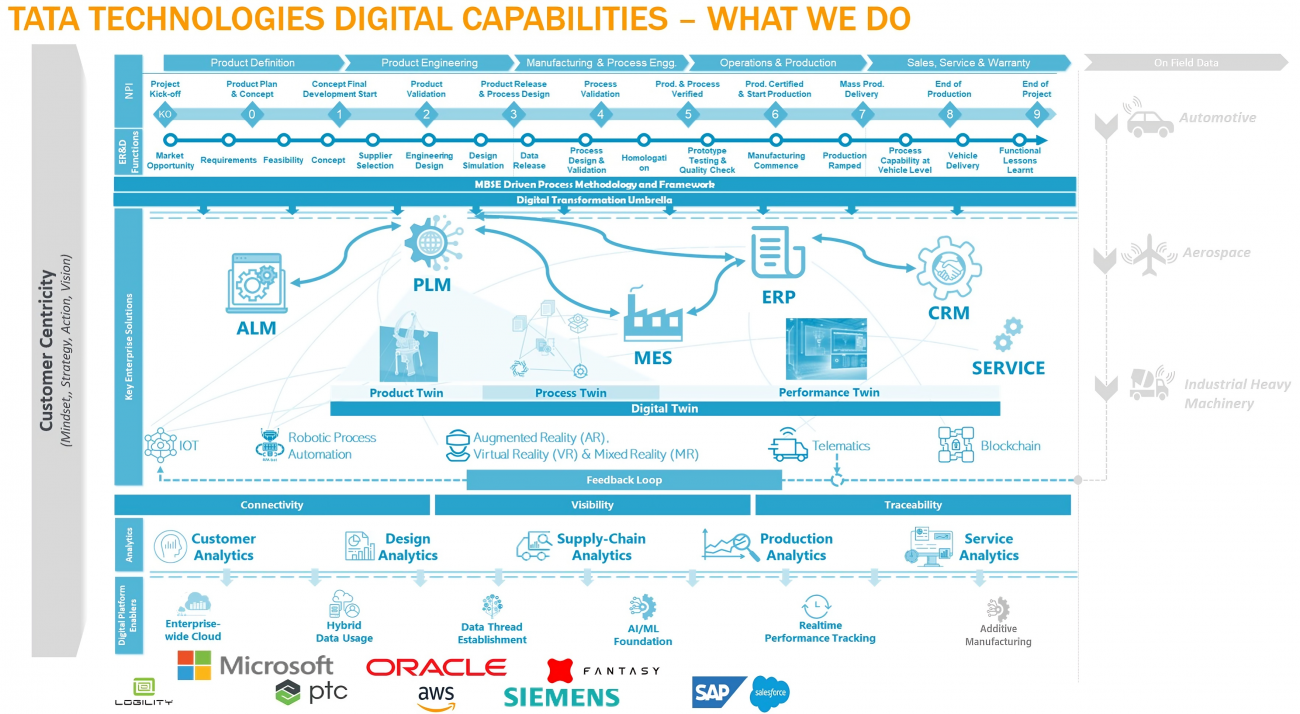FOR MANUFACTURING COMPETITIVE PRODUCTS

Product Lifecycle Management (PLM) has come a long way from being utilized as a repository for the CAD data authored in Mechanical CAD tools to managing the critical process areas for new product development (NPD).
New Product Development (NPD) process typically captures the journey of a product from ideation to retirement with multiple milestones along the journey, providing input and feedback to the corresponding milestones and business gates. The NPD journey starts with ideation, concept, design, development, prototype, validation, production, sales, service & warranty, and product retirement.
The present-day PLM
The present-day PLM predominantly addresses engineering aspects like product definition, product configurations, classification, Bill of Material (BOM) management, and change management of NPD process. It extends its reach to upstream and downstream areas, including requirements, manufacturing, quality, project management, and supplier management.
The critical elements of product data from Mechanical Design perspective and PLM’s ability to incorporate Mechanical CAD authoring tools have undergone significant evolution and maturation.
The transfer of CADBOM from CAD authoring tools to PLM, coupled with the concurrent generation of the corresponding Engineering BOM (EBOM), establishes EBOM as the primary BOM within PLM. Other BOMs like Purchase BOM (PBOM), Manufacturing BOM (MBOM), Plant specific BOM, Service BOM (SBOM) can be derivatives of EBOM.
The evolution for Electrical and Electronics (E&E) data that needs to be managed in PLM has begun, wherein the E&E data related to EBOM is transferred to PLM and utilized for collaboration with other streams and stakeholders (for example, design reviews, clash detection, etc.).
The present-day PLM enables concurrent engineering by providing a platform for collaboration of stakeholders, integration of systems among disciplines like design, engineering, manufacturing suppliers, etc. with an objective to enhance product quality and streamline the business process. This enables processes to run in parallel, thereby improving efficiency, productivity, and reducing time-to-market for products.
|
As the consumer gravitates more towards software-defined connected products, the businesses that cater to these needs have to naturally manufacture these products efficiently with mandated quality and higher margins. The products should be better in terms of value (real and perceived) in the segment they compete and be sustainable environmentally. |
The future of PLM
With a radical shift in consumer behavior, products too have evolved into ‘software-defined connected products’. They are complex (a combination of mechanical, electrical & electronics, and software) and connected (through Internet of Things [IoT]). They transmit product and user data to the cloud through 5G technologies and have a high volume of software, enabling updates over-the-air (OTA). For example, premium vehicles contain 150 million lines of software code, distributed among as many as 100 electronic control units (ECUs) and an array of sensors, cameras, radar, and light detection and ranging (lidar) devices.
“Once software was a part of the car. Now, software determines the value of a car,” notes Manfred Broy, emeritus professor of informatics at Technical University, Munich, and a leading expert on software in automobiles.

When businesses embark on a journey to create high-performing, software-defined connected products, they need to make sure that they have the pre-requisite foundation and framework that can bring process, systems, and data together and leverage Artificial intelligence (AI) for trends and analysis, predictive maintenance, etc., hosting enterprise-wide applications on cloud and connecting products through IoT, Augmented Reality and Virtual Reality for enhanced customer experience.
Businesses that aspire to manufacture competitive products now and also in the future with shorter time-to-market, thereby increasing margins, should consider the following aspects for next generation PLM solutions:
- Manufacturing ‘software-defined connected products’ that are sustainable should have an enterprise wide framework, whereby connected products are a natural outcome of efficient processes, integrated application(s) with which, data is seamlessly traced and consumed, and collaborations among people on topics like design reviews, quality improvements, cost optimizations happen with zero or limited effort.
- The ultimate objective for companies is to create a seamless NPD process with enterprise wide foundation or framework, which would have an integration between ALM-PLM-ERP-MES-CRM. This ecosystem will enable single source of truth for the product & traceability from Requirements Bill of Material (Requirements BOM) to CADBOM to Engineering BOM (EBOM) to Purchase BOM (PBOM) to Manufacturing BOM (MBOM) to Plant Specific BOM to Service BOM (SBOM) etc (Requirements BOM-CADBOM-EBOM-PBOM-MBOM-Plant BOM-SBOM)
- With global economies aligning towards achieving climate neutrality by 2050, businesses worldwide are compelled to shift towards sustainable products. This underscores the imperative for adopting next-generation Product Lifecycle Management (PLM) as a crucial strategy for businesses to thrive and endure. The integration of carbon calculators with PLM equips designers in the early stages of New Product Development (NPD) to make informed choices regarding materials, manufacturing processes, and more, facilitating the creation of sustainable products with reduced carbon emissions.
- Deploying enterprise-wide applications on the cloud facilitates seamless access for both internal and external stakeholders, partners, and vendors through web browsers. This reduces costs associated with maintaining on-premise hosted applications.
- Creating a strong foundation, which will enable digital twin (a digital representation in sync with the physical product) in its truest sense. This makes concepts such as enterprise change management and traceability across the entire new product development etc., become a reality.
- Establishing a single source of truth for the product(s) so that the product data is authored by a business unit within one application and utilized by other stakeholders, as well as other applications positioned either upstream or downstream in the process.
Conclusion
Businesses need the framework and foundation to be architecturally strong, yet be flexible, scalable, and secure. Hence, PLM is mandatory for businesses not just to succeed but also to stay afloat and relevant in these ever-growing and competitive markets where the customer has to see the value in the product(s) to buy them.
 |
Sundaram Shanmuga Tata Technologies |




 Facebook
Facebook.png) Twitter
Twitter Linkedin
Linkedin Subscribe
Subscribe